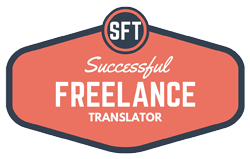Becoming a successful freelance translator is not an easy task. If you want to find better jobs, land better clients and grow your professional network you should definitely think about building your personal brand. The personal brand is a complex notion covering everything from recognizable design to expert knowledge and skills, online and offline reputation associated with your name. In this post, you will learn about the first steps you should make to start building your personal brand as a freelance translator.
Identify your goals
Having clear and achievable goals is the basis of your personal brand. Goals help to monitor your progress and understand if you are on the right track with your promotional efforts. As a rule, the primary goals are to earn more money and find better clients. However, your goals should be more specific, measurable and achievable. Therefore, to identify your goals, answer the following questions:
- How much do you want to earn per hour (week, month, year)
- How soon do you want to achieve these results (within 6 months, a year, etc.)?
- What is the volume of work required to keep with your earning expectations?
- How much time do you have to spend for such amount of work?
- How much time is left for branding and promotion?
Continue the list of questions and adjust it to specific conditions and personal expectations. You may also subdivide major goals into smaller achievable tasks and create an action plan for your freelance business development based on the goals.
Identify your target audience
The next step after setting up the goals is to identify your target audience. It is hard to reach the point if you target a wrong audience. In case of freelance translation business, we can easily identify two major groups: direct clients and translation companies.
You may try to target both groups but you should understand that it will take more time and resources to achieve good results. Moreover, not every translator is ready to work with direct clients. Cooperating with a translation agency is easier: the agency takes care of management and administration issues, it provides you with more or less regular workload and secures payment, etc. Many freelance translators never work with direct clients and prefer stable cooperation with reliable agencies.
On the other hand, working with direct clients can bring your more money. However, you shall be ready to take responsibility for all aspects of such cooperation, from customer relations and advertising to finances and taxes, etc.
If you made a choice between agencies and direct clients, you can go further and identify even smaller groups of prospects. In case of agencies, this can be a large translation agency covering all and any specializations/language pairs, or a boutique agency targeting specific markets, for example, technical translation agencies working with English-Russian and German-Russian language pairs only.
If you choose to work with direct clients, you can target a specific industry, for instance, legal firms or marketing agencies. Your further branding efforts will largely depend on your target audience, so spend as much time as you can to identify your ideal audience.
Determine your unique value proposition
Now that you know your target audience, you may determine a unique value proposition (UVP). Basically, value proposition is a clear statement that
- explains how your services solve customers’ problems or improve their situation,
- delivers specific benefits,
- tells the ideal customers why they should buy from you and not from the competitor.
There is no a universal formula to develop UVP, but I suggest to start with the following:
- Headline. Identify what is the main benefit you’re offering in one short sentence.
- Subheading or a 2-3 sentence paragraph. A specific explanation of what you do/offer, for whom and why is it useful.
- 3 bullet points. List the key benefits or features of your services
UVP can be used further for your personal website.
Build your own website
A personal website is more than just a portfolio. It’s your online headquarters – a powerful tool to represent yourself on the web, attract new clients and run a marketing campaign. Many translators have personal websites, however, according to my recent survey, 41% of translators don’t have any. So if you want to stand out with your freelance translation business, start building your website today. Now it is not difficult to start a website and, actually, you don’t need any programming skills. You may find answers to the most common questions about starting a personal website from my recent post or from the new episode of Blabbing Translators talk show:
Start blogging
You have set up your goals, identified your target audience, determined a unique value proposition and created a website. What should you do next? Start blogging! Develop a content plan and try to post at least twice per month. Even if you are extremely busy with translation tasks you will definitely find some time to write one new article in 14-days period. Try to identify the main problems of your target audience and provide helpful answers to resolve them. Promote your blog on social networks, forums and other related resources to increase the reach.
A single well-written, SEO-optimized article can bring you a new client when you promote it to the right audience. Afterwards, when your article will reach a certain position on search engine results page, people, who are searching for help, will find your posts and order your services right from your website.
Become a social networker
Networking is an important component that will help you build a strong personal brand. Allocate a couple of hours per week to improve your social media presence. It is hard to find a person who is not using Facebook, Twitter or LinkedIn nowadays. Why don’t you take an advantage of communication on social networks?! Join professional groups on Facebook or LinkedIn to find new connections and communicate with colleagues. Also, join our community of successful freelance translators on Facebook and follow SFT on Twitter. You can create a Facebook page, develop a perfect LinkedIn profile and set up a Twitter account to promote your services, share useful stuff with your followers and attract new clients.
Review and update your personal brand regularly
Conduct a short review of your branding work regularly to keep track of your progress. When you have certain goals and follow your action plan for personal brand development you will be able to see what works well and what should be changed. Personal brand is not a static image; it is a dynamic representation of your business that shall be up-to-date and relevant to your target audience.
Don’t waste your time on random job search and occasional gigs from bidding portals. Apply consistent and continuous approach to personal brand development and you will definitely find better-paying clients, ensure stable workload and earnings.
Do not forget to subscribe to SFT blog! Fill in your details in the sidebar on the right and click Subscribe button to receive our weekly updates.



